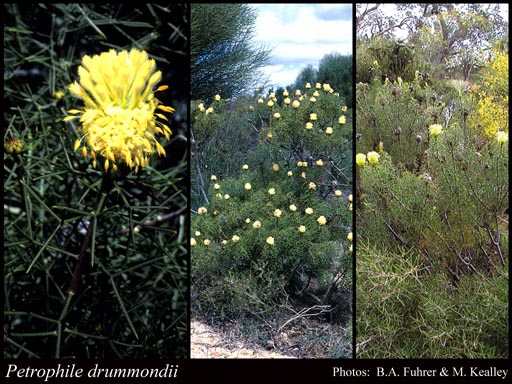- Reference
- Lehm., Pl.Preiss. [J.G.C.Lehmann] 1:496 (1845)
- Conservation Code
- Not threatened
- Naturalised Status
- Native to Western Australia
- Name Status
- Current
Many-branched, prickly, non-lignotuberous shrub, 0.4-1.2 m high. Fl. yellow/white-cream, Aug to Dec. Grey or yellow sand, sandy laterite.

Scientific Description
Shrubs, 1-1.5 m high; branchlets hairy, with straight hairs. Leaves alternate, 20-70 mm long, hairy; lamina terete, twice or more divided, pinnately divided, divided to the midrib, with (5-)13-17(-27) points or lobes; distance from base of leaf to lowest lobe 10-25 mm. Inflorescences viscid, yellow or orange. Perianth 14-18 mm long, hairy, the limb apex hairy all over; pistil 16-18 mm long; pollen presenter fusiform, hairy, 4.3-5.6 mm long. Cone with persistent scales, 25-40 mm long. Flowers in August, September, October, November or December. Occurs in the South-west (SW) Botanical Province(s), in the Geraldton Sandplains (GS), Swan Coastal Plain (SWA), Avon Wheatbelt (AW) or Jarrah Forest (JF) IBRA subregion(s).
Distribution
- IBRA Regions
- Avon Wheatbelt, Geraldton Sandplains, Jarrah Forest, Swan Coastal Plain.
- IBRA Subregions
- Dandaragan Plateau, Geraldton Hills, Katanning, Lesueur Sandplain, Merredin, Northern Jarrah Forest.
- Local Government Areas (LGAs)
- Beverley, Carnamah, Coorow, Cunderdin, Dandaragan, Irwin, Moora, Northam, Three Springs, Victoria Plains, Wickepin.